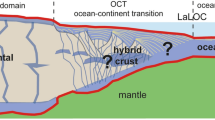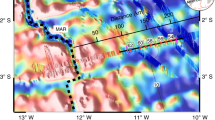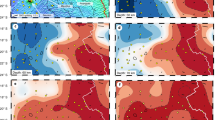Abstract
Quantifying the melt distribution and crustal structure across ridge-axis discontinuities is essential for understanding the relationship between magmatic, tectonic and petrologic segmentation of mid-ocean-ridge spreading centres. The geometry and continuity of magma bodies beneath features such as overlapping spreading centres can strongly influence the composition of erupted lavas1 and may give insight into the underlying pattern of mantle flow. Here we present three-dimensional images of seismic reflectivity beneath a mid-ocean ridge to investigate the nature of melt distribution across a ridge-axis discontinuity. Reflectivity slices through the 9° 03′ N overlapping spreading centre on East Pacific Rise suggest that it has a robust magma supply, with melt bodies underlying both limbs and ponding of melt beneath large areas of the overlap basin. The geometry of melt distribution beneath this offset is inconsistent with large-scale, crustal redistribution of melt away from centres of upwelling2,3. The complex distribution of melt seems instead to be caused by a combination of vertical melt transport from the underlying mantle and subsequent focusing of melt beneath a magma freezing boundary in the mid-crust.
This is a preview of subscription content, access via your institution
Access options
Subscribe to this journal
Receive 51 print issues and online access
$199.00 per year
only $3.90 per issue
Buy this article
- Purchase on Springer Link
- Instant access to full article PDF
Prices may be subject to local taxes which are calculated during checkout




Similar content being viewed by others
References
Sinton, J. M., Wilson, D. S., Christie, D. M., Hey, R. N. & Delaney, J. R. Petrologic consequences of rift propagation on oceanic spreading ridges. Earth Planet. Sci. Lett. 62, 193–207 ( 1983).
Macdonald, K. C. et al. A new view of the mid-ocean ridge from the behaviour of the ridge-axis discontinuities. Nature 335, 217–225 (1988).
Wang, X., Cochran, J. R. & Barth, G. Gravity anomalies, crustal thickness and the pattern of mantle flow at the fast spreading East Pacific Rise, 9°N-10°N: Evidence for three-dimensional upwelling. J. Geophys. Res. 101, 17927–17940 (1996).
Lonsdale, P. Segmentation of the Pacific-Nazca spreading center, 1°N-20°S. J. Geophys. Res. 94, 12197–12225 (1989).
Macdonald, K. C. & Fox, P. J. Overlapping spreading centres: new accretion geometry on the East Pacific Rise. Nature 302, 55–58 ( 1983).
Lonsdale, P. Overlapping rift zones at the 5.5°S offset of the East Pacific Rise. J. Geophys. Res. 88, 9393–9406 (1983).
Langmuir, C. H., Bender, J. F. & Batiza, R. Petrologic and tectonic segmentation of the East Pacific Rise, 5°30′-14°30′N. Nature 322 , 422–429 (1986).
Scheirer, D. S & Macdonald, K. C. Variation in cross-sectional area of the axial ridge along the East Pacific Rise: Evidence for the magmatic budget of a fast spreading center. J. Geophys. Res. 98, 7871–7886 (1993).
Magde, L. S., Detrick, R. S. & TERA Group. Crustal and upper mantle contribution to the axial gravity anomaly at the southern East Pacific Rise. J. Geophys. Res. 100, 3747–3766 (1995).
Toomey, D. R., Purdy, G. M., Solomon, S. C. & Wilcock, W. S. D. The three-dimensional seismic velocity structure of the East Pacific Rise near latitude 9°30′N. Nature 347, 639–645 (1990).
Singh, S. C., Kent, G. M., Collier, J. S., Harding, A. J. & Orcutt, J. A. Melt to mush variations in crustal magma properties along the ridge crest at the southern East Pacific Rise. Nature 394, 874–878 (1998).
Dunn, R. A. & Toomey, D. R. Seismological evidence for three-dimensional melt migration beneath the East Pacific Rise. Nature 388, 259–262 (1997).
Mutter, J. C. et al. Magma distribution across ridge axis discontinuities on the East Pacific Rise (8°40′ to 9°50′ North) from multichannel seismic images. Nature 336, 156– 158 (1988).
Collier, J. S. & Sinha, M. C. Seismic images of a magma chamber beneath the Lau Basin back-arc spreading centre. Nature 346, 646–648 ( 1990).
Kent, G. M., Harding, A. J. & Orcutt, J. A. Distribution of magma beneath the East Pacific Rise near the 9°03′N overlapping spreading center from forward modeling of common depth point data. J. Geophys. Res. 98, 13971–13996 (1993).
Carbotte, S. & Macdonald, K. C. East Pacific Rise 8°-10°30′N: Evolution of ridge segments and discontinuities from SeaMARC II and three-dimensional magnetic studies. J. Geophys. Res. 97, 6959 –6982 (1992).
Harding, A. J., Kent, G. M. & Orcutt, J. A. A multichannel seismic investigation of the upper crustal structure at 9°N on the East Pacific Rise: Implications for crustal accretion. J. Geophys. Res. 98, 13925– 13944 (1993).
Carbotte, S., Mutter, J. C. & Wu, L. Contribution of volcanism and tectonism to axial and flank morphology of the southern East Pacific Rise, 17°10′-17°40′, from a study of layer 2A geometry. J. Geophys. Res. 102, 10165–10184 (1997).
Christeson, G. L., Kent, G. M., Purdy, G. M. & Detrick, R. S. Extrusive thickness variability at the East Pacific Rise, 9°-10°N: Constraints from seismic techniques. J. Geophys. Res. 101, 2859–2873 (1996).
Hooft, E. E. E., Schouten, H. & Detrick, R. S. Constraining crustal emplacement processes from the variation of seismic layer 2A thickness at the East Pacific Rise. Earth Planet. Sci. Lett. 142, 289– 309 (1996).
Kent, G. M., Harding, A. J. & Orcutt, J. A. Evidence for a smaller magma chamber beneath the East Pacific Rise at 9°30′N. Nature 344, 650–653 (1990).
Bazin, S. Three-dimensional Crustal Structure of East Pacific Rise Discontinuities from Tomographic Inversions. Thesis, Univ. California, San Diego ( 2000).
Singh, S. C., Collier, J. S., Harding, A. J., Kent, G. M. & Orcutt, J. A. Seismic evidence for a hydrothermal layer above the solid roof of the axial magma chamber at the southern East Pacific Rise. Geology 27, 219– 222 (1999).
Phipps Morgan, J. & Chen, Y. J. The genesis of oceanic crust: Magma injection, hydrothermal circulation, and crustal flow. J. Geophys. Res. 98, 6283– 6297 (1993).
Detrick, R. S. et al. Multichannel imaging of the axial magma chamber along the East Pacific Rise between 9°N and 13°N. Nature 326, 35–41 (1987).
Phipps Morgan, J. & Parmentier, E. M. Causes and rate-limiting mechanisms of ridge propagation: a fracture mechanics model. J. Geophys. Res. 90, 8603– 8612 (1985).
Sempéré, J.-C., Macdonald, K. C. & Miller, S. P. Overlapping spreading centres: 3-D inversion of the magnetic field at 9°03′N on the East Pacific Rise. Geophys. J. R. Astron. Soc. 79, 799 –811 (1984).
Batiza, R. & Mutter, J. C. Variability in oceanic crustal thickness and structure: Multichannel seismic reflection results from the northern East Pacific Rise. J. Geophys. Res. 101, 17951–17975 (1996).
Barth, G. A. & Mutter, J. C. Variability in oceanic crustal thickness and structure: Multichannel seismic reflection results from the northern East Pacific Rise. J. Geophys. Res. 101, 17951–17975 (1996).
Yilmaz, O. Seismic Data Processing (Society of Exploration Geophysicists, Tulsa, 1987).
Acknowledgements
We thank the officers and crew of the RV Maurice Ewing for around-the-clock help during the 47-day-long cruise; H. Avendonk, D. Boschi, A. Cherrett, A. Greer, P. Henkart, C. Hollinshead, S. Hussenoeder, T. Owen and P. Zimmer for assistance with instrumentation and watch-standing duties during the experiment; and R. Detrick and D. Toomey for comments that significantly improved this Letter. Data-processing software was provided by Paradigm Geophysical, Houston, Texas. Focus 3-D was used for the three-dimensional binning, stacking and migration of the multichannel seismic data. Data presentation of the three-dimensional volume was facilitated through visualization modules within Focus 3-D and VoxelGeo. The ARAD seismic experiment is an international collaborative project between investigators at the Scripps Institution of Oceanography and the University of Cambridge, with financial support from the RIDGE program/National Science Foundation (USA), British Institutions Reflection Profiling Syndicate (BIRPS), and the Natural Environment Research Council (UK). Additional matching funds for computer visualization and data storage were provided by the Scripps Institution of Oceanography and the Cecil H. and Ida M. Green Foundation for Earth Sciences.
Author information
Authors and Affiliations
Corresponding author
Supplementary information
Rights and permissions
About this article
Cite this article
Kent, G., Singh, S., Harding, A. et al. Evidence from three-dimensional seismic reflectivity images for enhanced melt supply beneath mid-ocean -ridge discontinuities. Nature 406, 614–618 (2000). https://doi.org/10.1038/35020543
Received:
Accepted:
Issue Date:
DOI: https://doi.org/10.1038/35020543
This article is cited by
-
Osmium and zinc isotope constraints on the origin of chromitites from the Yarlung-Zangbo ophiolites, Tibet, China
Mineralium Deposita (2024)
-
Porosity evolution of mafic crystal mush during reactive flow
Nature Communications (2023)
-
Multi-scale Quantitative Risk Analysis of Seabed Minerals: Principles and Application to Seafloor Massive Sulfide Prospects
Natural Resources Research (2019)
-
Segmentation of mid-ocean ridges attributed to oblique mantle divergence
Nature Geoscience (2016)
-
Seismic evidence of a two-layer lithospheric deformation in the Indian Ocean
Nature Communications (2015)
Comments
By submitting a comment you agree to abide by our Terms and Community Guidelines. If you find something abusive or that does not comply with our terms or guidelines please flag it as inappropriate.



